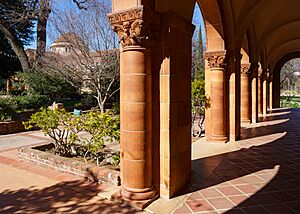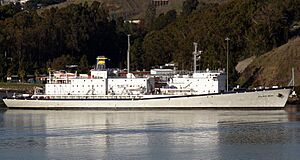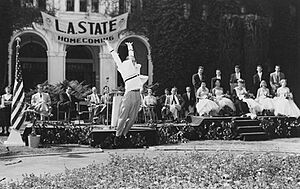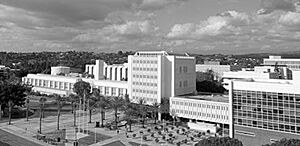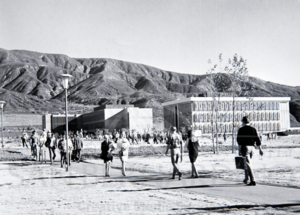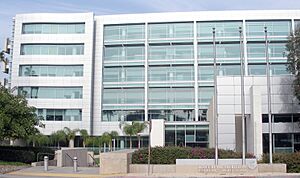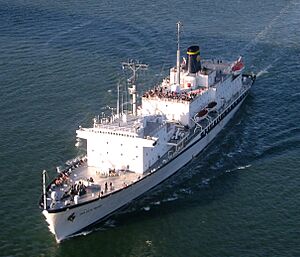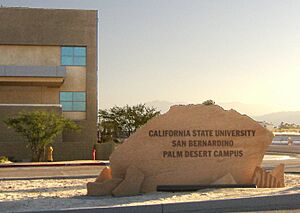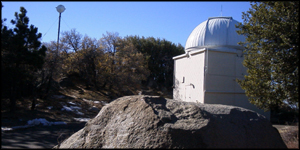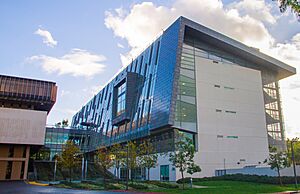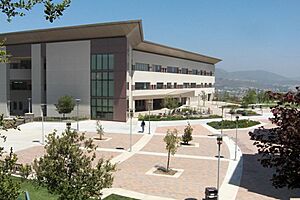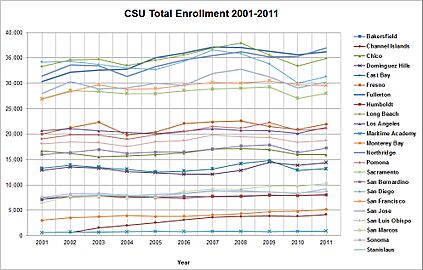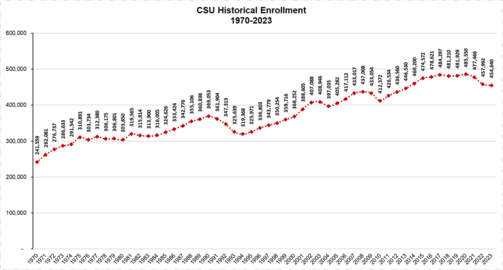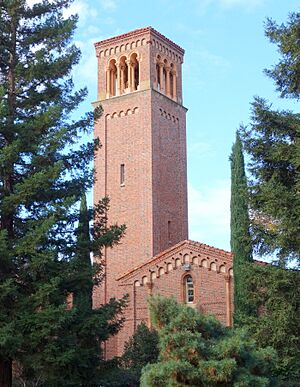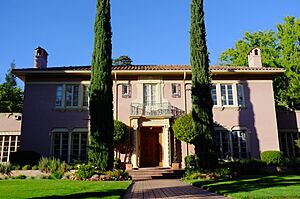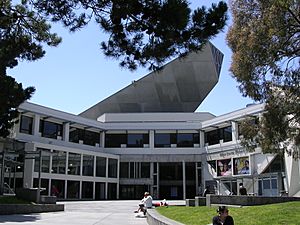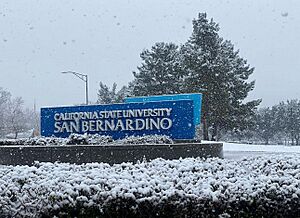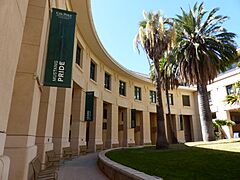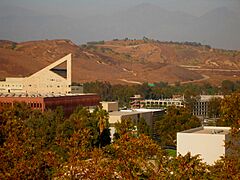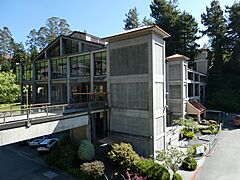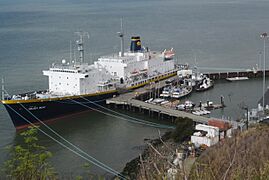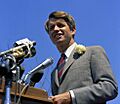California State University facts for kids
 |
|
| Motto | Vox Veritas Vita (Latin) |
|---|---|
|
Motto in English
|
"Voice, Truth, Life" (Speak the truth as a way of life.) |
| Type | Public university system |
| Established | 1857 |
| Endowment | $2.8 billion (2023–24) |
| Budget | $8.4 billion (2023–24) |
| Chancellor | Mildred García |
| Undergraduates | 408,248 (2023–24) |
| Postgraduates | 53,364 (2023–24) |
| Location |
,
,
United States
|
| Campus | 22 campuses |
| Colors | Red & White |
| Affiliations | State of California |
The California State University (often called Cal State or CSU) is a large group of public universities in California. It is the biggest public university system in the United States. CSU has 22 main campuses and seven smaller centers. Together, they teach over 461,000 students and employ more than 63,000 teachers and staff.
In California, CSU is one of three public higher education systems. The others are the University of California and the California Community Colleges. The main office for the CSU system is in Long Beach, California.
The CSU system was officially started in 1960. However, its history goes back to the California State Normal Schools, which began in 1857. CSU is known for giving out the most bachelor's degrees in the country. More than 110,000 students graduate from CSU every year. The system also helps California's economy by supporting over 209,000 jobs.
In the 2015–16 school year, CSU awarded more than half of California's new teaching degrees. It also gave out a third of the state's information technology bachelor's degrees. CSU graduates more students in business, criminal justice, engineering, and agriculture than all other California colleges combined. About half of all bachelor's degrees in California come from CSU. Also, most bachelor's degrees earned by Latino, African American, and Native American students in California are from CSU.
Since 1961, over four million people have earned a degree from the CSU system. CSU offers more than 1,800 different degree programs. In fall 2024, about 40% of CSU's teachers had permanent positions.
Contents
- History of California State University
- How California State University is Managed
- CSU Campuses
- Other CSU Locations and Facilities
- Research and Academic Programs
- How to Get Admitted to CSU
- Impact of California State University
- Campus Naming Styles
- Differences Between CSU and UC Systems
- Images for kids
- See also
History of California State University
Early Schools for Teachers

The California State University system started from the Minns Evening Normal School. This school was founded in 1857 by George W. Minns in San Francisco. A "normal school" was a place that trained future teachers. It was the first school of its kind in California.
The state took over the school in 1862. It moved to San Jose and was renamed the California State Normal School. This school later became San Jose State University. In 1882, a branch of this school opened in Los Angeles. By 1887, the state removed "California" from the names of these schools, calling them simply State Normal Schools.
Later, more state normal schools were started in Chico (1887) and San Diego (1897). These schools were independent and had their own leaders. By the late 1800s, the San Jose school was graduating about 130 teachers each year. It was one of the most famous normal schools in the West.
In 1919, the State Normal School in Los Angeles became part of the University of California. In 1927, it was renamed the University of California at Los Angeles.
Becoming State Teachers Colleges

In May 1921, a big change happened for California's schools. The State Normal Schools were renamed State Teachers Colleges. Their old leadership groups were removed. They were then overseen by the new California Department of Education in Sacramento. This meant they were managed by state officials. Many people started calling these colleges by their city names, like "San Jose State."
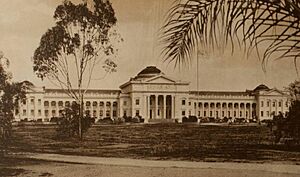
From 1921 to 1960, the colleges had some freedom in daily tasks. However, their money was controlled by the state government, just like other state offices. This was different from the University of California. This system meant that CSU employees are still paid by the state today.
During the 1920s and 1930s, these colleges started to offer more than just teacher training. They began to offer a full liberal arts education. This meant students could study many different subjects. The goal was to prepare teachers to teach all grades from kindergarten to high school. Leaders like Charles McLane at Fresno State helped make this happen.
Changing to State Colleges

In 1932, a study suggested that the State Teachers Colleges should be managed by the University of California. But the colleges fought to stay independent. In 1935, the state officially upgraded them to State Colleges. They were allowed to offer four-year degrees in many subjects. However, they still remained under the Department of Education.
During World War II, Santa Barbara State College was moved to the University of California system in 1944. After this, supporters of the state colleges changed the California state constitution in 1946. This was to stop it from happening again.
After World War II, many new state colleges were opened. Colleges were established in Los Angeles, Sacramento, and Long Beach between 1947 and 1949. Seven more were added from 1957 to 1960. Six more state colleges were founded after the Donahoe Higher Education Act of 1960. This brought the total number to 23.
The California State Colleges System

In the 1950s, the state colleges wanted more control over their own operations. They felt that the State Board of Education and the State Superintendent of Public Instruction were too influenced by the University of California. Several college presidents pushed for a new system with its own board. They also wanted to offer more advanced degrees and get funding for research.
Lawmakers often created new state colleges based on local interests, not always on real need. For example, a new college was created in Turlock in 1957. This happened because a powerful senator was from that town.
In April 1960, the California Master Plan for Higher Education and the Donahoe Higher Education Act changed things. The state colleges were grouped into the State College System of California. They were no longer under the Department of Education. A new board of trustees and a system-wide leader (chancellor) were put in charge. In March 1961, the system was renamed the California State Colleges (CSC).
The Master Plan stated that the University of California would be the main place for research and doctoral degrees. CSU could only offer doctoral degrees in special joint programs with UC or other universities. CSU's main job was to provide undergraduate and master's level teaching. This plan was made to ensure that California had different types of universities, each with a clear purpose.
The first chancellor of the California State Colleges was Buell G. Gallagher (1961–1962). He resigned after a short time. Glenn Dumke became the second chancellor (1962–1982). He followed the Master Plan's rules for CSU, even though some people wanted CSU to become more like UC.
In 1961, the main office for the California State Colleges moved from Sacramento to Inglewood, near Los Angeles. This office was sometimes called the "imperial headquarters." In 1965, it moved to a larger office in Los Angeles.
Becoming California State University and Colleges

In 1966, there was talk about changing the system's name to California State University. After much discussion, the system was renamed the California State University and Colleges in 1971. Governor Ronald Reagan signed the bill into law.
Following this, in May 1972, the board of trustees voted to rename most of the campuses. They became "California State University," followed by their city name. For example, San Jose State College became California State University, San Jose. However, some campuses, like San Francisco State, kept their original names because people liked them better.
In September 1976, the chancellor's office moved to a new building in Long Beach. This was the first time CSU owned its own main office building.
The California State University Today

In 1982, two big changes happened. First, the word "colleges" was dropped from the system's name. It became simply the California State University. Second, W. Ann Reynolds became the third chancellor. She tried to get more funding for CSU and the right to award doctorates independently. However, she was not successful in getting independent doctorate degrees.

The main office building in Long Beach had problems, so in 1998, CSU moved to its current headquarters at 401 Golden Shore. The old building was torn down and became a parking lot.
Today, CSU campuses include many types of universities. There are general universities, polytechnic universities (focused on science and technology), and the only maritime academy in the western United States.
In May 2020, due to the COVID-19 pandemic, all 23 CSU campuses moved most of their classes online for the Fall 2020 semester.
In January 2024, CSU faculty members went on strike for better pay. The strike involved 30,000 faculty members across all 23 campuses. It ended quickly with an agreement for pay increases and other benefits.
In 2025, the number of CSU campuses changed slightly. Cal Poly, San Luis Obispo, took over Cal State Maritime. It became an off-campus branch called Cal Poly, Maritime Academy.
How California State University is Managed
The California State University is managed by a group called the Board of Trustees. This board has 25 members. They choose the Chancellor of the California State University, who is the main leader of the whole system. The board also chooses the president for each individual campus.
Teachers from each campus elect representatives to the Academic Senate of the California State University. This group suggests academic rules to the Board of Trustees through the Chancellor.
The Board of Trustees
The 25-member Board of Trustees manages the California State University. It includes:
- The governor of California (who is the president of the board)
- Sixteen members chosen by the governor and approved by the Senate
- Two students from CSU, chosen by the governor
- One tenured faculty member, chosen by the governor from a list provided by the Academic Senate
- One representative from the alumni associations
- Four other members who are part of the board because of their jobs:
- The Lieutenant Governor
- The Speaker of the Assembly
- The State Superintendent of Public Instruction
- The CSU Chancellor
The board meets six times a year in Long Beach.
The Chancellor's Role
The Chancellor is the main leader of the CSU system. All the presidents of the individual campuses report directly to the Chancellor.
Past Chancellors
Here are the people who have served as Chancellor of the California State University system:
| No. | Image | Chancellor | Start | End |
|---|---|---|---|---|
| 1 |  |
Buell Gallagher | July 1, 1961 | February 13, 1962 |
| 2 |  |
Glenn S. Dumke | April 5, 1962 | August 31, 1982 |
| 3 | W. Ann Reynolds | September 1, 1982 | May 16, 1990 | |
| interim | Ellis E. McCune | May 16, 1990 | July 31, 1991 | |
| 4 |  |
Barry Munitz | August 1, 1991 | December 31, 1998 |
| 5 |  |
Charles B. Reed | January 1, 1998 | December 31, 2012 |
| 6 |  |
Timothy P. White | January 1, 2013 | December 31, 2020 |
| 7 |  |
Joseph I. Castro | January 4, 2021 | February 17, 2022 |
| Acting | Steve Relyea | February 17, 2022 | April 30, 2022 | |
| interim | Jolene Koester | May 1, 2022 | September 30, 2023 | |
| 8 | Mildred García | October 1, 2023 | present |
Student Government
All 22 CSU campuses have student government groups. These groups are part of the California State Student Association (CSSA). Student organizations help provide activities that are important for college life but not part of regular classes.
CSU Campuses
The CSU system has 22 campuses. Ten are in Northern California and twelve are in Southern California. Here is a list of the campuses, ordered by when they were founded:
| Campus | School name | Founded | Enrollment (Fall 2024) |
Athletics | |
|---|---|---|---|---|---|
| Affiliation | Nickname | ||||
 San José |
San Jose State University | 1857 | 33,158 | NCAA D-I | Spartans |
 Chico |
California State University, Chico | 1887 | 14,581 | NCAA D-II
CCAA |
Wildcats |
 San Diego |
San Diego State University | 1897 | 39,373 | NCAA D-I Mountain West (Pac-12 in 2026) |
Aztecs |
 San Francisco |
San Francisco State University | 1899 | 22,357 | NCAA D-II
CCAA |
Gators |
 San Luis Obispo |
California Polytechnic State University, San Luis Obispo | 1901 | 22,842 | NCAA D-I Big West |
Mustangs |
 Fresno |
California State University, Fresno (Fresno State) |
1911 | 24,310 | NCAA D-I Mountain West (Pac-12 in 2026) |
Bulldogs |
 Humboldt Arcata |
California State Polytechnic University, Humboldt | 1913 | 6,045 | NCAA D-II
CCAA |
Lumberjacks |
 Pomona |
California State Polytechnic University, Pomona | 1938 | 27,196 | NCAA D-II
CCAA |
Broncos |
 Los Angeles |
California State University, Los Angeles | 1947 | 22,740 | NCAA D-II
CCAA |
Golden Eagles |
 Sacramento |
California State University, Sacramento (Sacramento State) |
1947 | 30,883 | NCAA D-I Big Sky |
Hornets |
 Long Beach |
California State University, Long Beach (Long Beach State) |
1949 | 41,189 | NCAA D-I Big West |
The Beach |
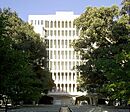 Fullerton |
California State University, Fullerton | 1957 | 42,999 | NCAA D-I Big West |
Titans |
 Stanislaus |
California State University, Stanislaus | 1957 | 9,295 | NCAA D-II
CCAA |
Warriors |
 East Bay Hayward |
California State University, East Bay | 1957 | 10,892 | NCAA D-II
CCAA |
Pioneers |
 Northridge |
California State University, Northridge | 1958 | 36,848 | NCAA D-I Big West |
Matadors |
 Dominguez Hills Carson |
California State University, Dominguez Hills | 1960 | 14,262 | NCAA D-II
CCAA |
Toros |
 Sonoma Rohnert Park |
Sonoma State University | 1960 | 5,784 | — | Seawolves |
 San Bernardino |
California State University, San Bernardino | 1965 | 17,900 | NCAA D-II
CCAA |
Coyotes |
 Bakersfield |
California State University, Bakersfield | 1965 | 10,036 | NCAA D-I Big West |
Roadrunners |
 San Marcos |
California State University, San Marcos | 1989 | 14,655 | NCAA D-II
CCAA |
Cougars |
 Monterey Bay Marina/Seaside |
California State University, Monterey Bay | 1994 | 7,302 | NCAA D-II
CCAA |
Otters |
 Channel Islands Camarillo |
California State University, Channel Islands | 2002 | 4,880 | — | Dolphins |
Other CSU Locations and Facilities
Off-Campus Branches
Some CSU universities have opened smaller branches away from their main campus. These branches make education easier to reach for more students. They offer full degree programs, and students there have the same status as those on the main campus. For example, California State University, Channel Islands, used to be a branch of CSU Northridge before becoming its own university.
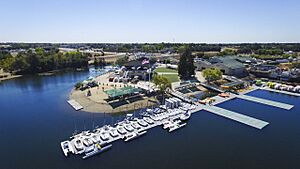
Here are some universities and their off-campus branches:
- California Polytechnic State University, San Luis Obispo
- Cal Poly, Solano Campus
- California State University, Bakersfield
- Antelope Valley (in Lancaster, California)
- California State University, Chico
- Redding (with Shasta College)
- California State University, Fullerton
- Garden Grove
- Irvine
- California State University, East Bay
- Concord
- Oakland (Professional & Conference Center)
- California State University, Fresno
- Visalia
- California State University, Los Angeles
- Downtown Los Angeles
- California State University, Monterey Bay
- Salinas (Professional & Conference Center)
- California State University, San Bernardino
- Palm Desert
- California State University, San Marcos
- Temecula/Murrieta
- San Diego State University
- Imperial Valley (in Brawley, California and Calexico, California)
- SDSU-Georgia (in Tbilisi in the former Soviet Republic of Georgia)
- San Francisco State University
- Downtown Campus (in San Francisco, California)
- Sierra Nevada Field Campus (in Calpine, California)
- Romberg Tiburon Campus (in Tiburon, California)
- California State University, Stanislaus
- Stockton, California
Research Laboratories
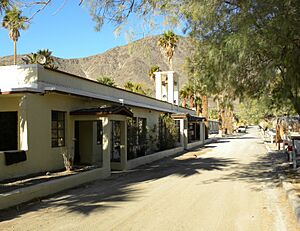
The CSU system also owns and runs several research facilities:
- Desert Studies Center: A research site managed by California State University, Fullerton.
- Moss Landing Marine Laboratories: An independent campus managed by San Jose State University. It is an oceanographic lab in the Monterey Bay area.
- Southern California Marine Institute: An oceanographic lab in the Los Angeles Basin.
- Telonicher Marine Laboratory: At Cal Poly Humboldt in Trinidad, CA. It is a marine research lab on the North California coast. It is home to the research vessel RV Coral Sea.
Observatories
The Mount Laguna Observatory, started in 1968, is the oldest observatory in the CSU system. It is managed by San Diego State's Department of Astronomy. Other CSU observatories include the Sonoma State Observatory and the Murillo Family Observatory. The Murillo Family Observatory is the newest and is managed by California State University, San Bernardino.
Research and Academic Programs
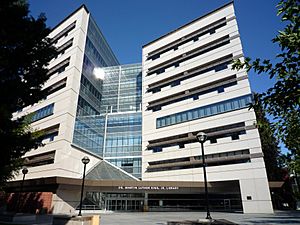
The California State University and most of its campuses are members of important university groups. These include the Association of Public and Land-grant Universities (APLU) and the American Association of State Colleges and Universities (AASCU).
CSU is also a founding member of CENIC. This group provides very fast internet connections for research and education in California.
The California State University Program for Education and Research in Biotechnology (CSUPERB) helps train people for jobs in biotechnology. It gives out grants, holds events, and works with businesses. This program involves students and teachers from many different subjects at all 22 CSU campuses.
The Hospitality Management Education Initiative (HMEI) started in 2008. It helps train leaders for California's hospitality industry (like hotels and restaurants). CSU awarded 95% of hospitality bachelor's degrees in the state in 2011.
ABET is a group that checks the quality of college programs in science, computing, and engineering. The California State University has 18 colleges with ABET-approved engineering programs.
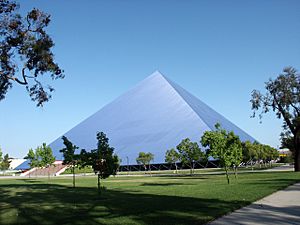
How to Get Admitted to CSU
Historically, it has been a bit easier to get into CSU than into the UC system. However, both systems require students to complete specific high school courses. CSU tries to accept students from the top one-third of California high school graduates. UC aims for the top one-eighth. Both systems also give priority to students transferring from California community colleges. This helps encourage students to start at a community college.
Some CSU campuses have higher admission standards because many qualified students apply. This makes getting into these schools more competitive. These include:
- Bakersfield (for nursing)
- Channel Islands (for nursing)
- Chico (for music and nursing)
- East Bay (for nursing)
- Fullerton
- Humboldt (for nursing)
- Long Beach
- Los Angeles
- Northridge (for accounting, cinema, and music)
- Pomona
- Sacramento (for business, criminal justice, graphic design, nursing, psychology)
- San Bernardino (for criminal justice, kinesiology, nursing, psychology, social work)
- San Diego
- San Francisco (for nursing, social work, and undeclared majors interested in nursing)
- San Jose
- San Luis Obispo
- San Marcos (for biological sciences, business, electrical engineering, nursing, software engineering)
- Sonoma (for criminology, human development, nursing, psychology, sociology)
- Stanislaus (for nursing)
Five CSU campuses are very popular for both new students and transfers. This means getting into any major at these schools is competitive for the 2025–26 school year. These five campuses are Fullerton, Long Beach, San Diego, San Jose, and San Luis Obispo.
The only CSU campuses that are not competitive for any academic program are Dominguez Hills, Fresno, and Monterey Bay.
- Enrollment at the California State University
Student Diversity
| Campuses | Under- graduate |
Graduate & post-bac |
|
|---|---|---|---|
| American Indians or Alaskan Natives | (<1%) | (<1%) | |
| Asian | 15.5% | 15.8% | |
| Black or African American | 4.1% | 4.2% | |
| Hispanic and Latino Americans (includes Chicanos, Other Latino and White Hispanics) |
48.9% | 50.1% | |
| Native Hawaiian or Other Pacific Islander | (<1%) | (<1%) | |
| Non-Hispanic White | 20.1% | 19.6% | |
| Two or more races | 4.7% | 4.8% | |
| Unknown | 3.2% | 3.1% | |
| International students | 3.0% | 1.9% |
A study in 2016 estimated that about one in ten Cal State students experienced homelessness while in college.
Impact of California State University
CSU awards over 110,000 degrees each year. This is almost half of all bachelor's degrees and a quarter of all master's degrees in California. The entire 22-campus system supports over 209,000 jobs across the state. It also generates $1.6 billion in tax money. The total money spent related to CSU is about $26.9 billion.
CSU produces many graduates in important fields. For example, 62% of bachelor's degrees in agriculture and 54% in business come from CSU. It is also the state's largest source of teachers. More than half of California's new teachers come from CSU, adding nearly 12,500 teachers each year.
Over the last 10 years, CSU has greatly improved programs for students who might not have had many opportunities. For example, 56% of bachelor's degrees given to Latino students in California are from CSU. In Fall 2008, 42% of new students came from California Community Colleges.
Campus Naming Styles
The UC system has a clear way of naming its campuses, like "University of California, Berkeley." Most CSU campuses follow a similar style, such as "California State University, Long Beach." However, some are named simply for their city or county, like San Francisco State University or San Jose State University.
Some campuses, like Fresno and Sacramento, officially use the "California State University" name. But they often call themselves "Fresno State" or "Sacramento State," especially for sports. Other campuses like Chico, Long Beach, and Stanislaus also use "Location State" for their sports teams. Northridge uses "CSUN" for its sports and marketing.
Channel Islands and San Marcos are the only campuses whose names do not include a comma. Some people believe that the less consistent naming of CSU campuses makes the system seem less important compared to the University of California.
- Cal Poly names
Differences Between CSU and UC Systems
Both the California State University (CSU) and the University of California (UC) are public universities. They are both funded by the state. Even though UC has fewer students, its largest campus, UCLA, has a budget almost as big as the entire CSU system. This is because UC focuses more on research and has large medical centers.
Teachers at CSU spend more time teaching and advising students. Teachers at UC spend more time on research. The former CSU Chancellor, Dr. Charles B. Reed, said that California is big enough for two great public university systems. One (UC) focuses on research, and the other (CSU) focuses on teaching. However, CSU spends less money per student. Also, because CSU does not have a main focus on research or independent doctoral programs, some people think it is less prestigious than UC.
According to the California Master Plan for Higher Education (1960), both CSU and UC can give out bachelor's and master's degrees. They can also give professional certifications. However, only the University of California has the power to give out Ph.D degrees and professional degrees in fields like law, medicine, and dentistry. Since 2005 and 2010, CSU can now offer doctoral degrees in Education and Physical Therapy. CSU also offers some Ph.D degrees and other doctorates as joint programs with UC or private universities.
There are 22 CSU campuses with about 437,000 students. There are 10 UC campuses with about 237,000 students. The cost of CSU tuition is about half that of UC.
CSU and UC use the terms "president" and "chancellor" differently. At CSU, each campus is led by a president who reports to the system-wide chancellor. At UC, each campus is led by a chancellor who reports to the system-wide president.
CSU has traditionally been more welcoming to older students. It offers more evening and online degree programs. Also, CSU schools, especially in cities, have often served students who live nearby and commute. This is changing as CSU schools grow and attract students from further away.
Most CSU campuses use the semester system (two main terms per year). Most UC campuses use the quarter system (four shorter terms per year). However, some UC campuses like UC Berkeley and UC Merced use the semester system. Since fall 2014, CSU has been changing its remaining quarter campuses to the semester calendar. Cal State LA and Cal State Bakersfield changed in fall 2016. Cal State East Bay and Cal Poly Pomona changed in fall 2018. Cal State San Bernardino changed in fall 2020. Cal Poly San Luis Obispo plans to change by fall 2026.
Images for kids
-
Robert F. Kennedy addresses the crowd at San Fernando Valley State College (modern day California State University, Northridge) in 1968.
See also
 In Spanish: Universidad Estatal de California para niños
In Spanish: Universidad Estatal de California para niños


